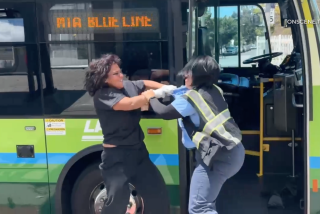Safety Panel Considers Rules on TV News Vans
- Share via
Worried that a Los Angeles television reporter’s near-fatal accident could have killed or injured dozens of other people as well, state officials are poised to adopt the nation’s first safety rules for TV news vans.
Occupational Safety and Health Standards Board regulations to be considered today would require special safety devices to prevent TV reporters from accidentally raising microwave antenna masts--which go as high as 70 feet--into power lines.
Experts say the state’s estimated 1,000 microwave television trucks have the potential to kill hundreds if their antennas touch overhead electric lines at a crowded news scene.
The proposed regulations would require frequent inspection of news vans to make certain that mast-raising safety levers and warning alarms have not been disabled. Training of photographers, reporters and TV news assignment supervisors would be required.
The safety crackdown was sought by five Southern California television labor unions following the May 22, 2000, accident in which a KABC-TV Channel 7 news van mast was raised more than 40 feet into a 19,980-volt power line in Hollywood. Although not directly below the lines, the van was parked on an uneven surface that caused the mast to lean into them.
Reporter Adrienne Alpert, then 49, was severely burned when she stepped out of the truck and touched the ground, sending the electric current surging through her body. Third-degree burns forced the amputation of her lower right leg, left forearm, part of her left foot and several fingers on her right hand.
KABC photographer Heather MacKenzie, 47, and a Los Angeles police officer suffered less serious electrical shocks.
Onlookers screamed at Alpert to run when the microwave dish rubbed against one of the lines and began sparking. But her arm touched the truck’s door as her foot touched the parking pad, grounding her. Investigators later credited a water faucet on the wall of a nearby auto repair shop with saving Alpert’s life. Most of the electric line’s high voltage arced from the truck’s right front tire to the faucet. The jolt blew out the copper pipe’s soldered joints, flooding the repair shop with water.
“What if that had been a gas line and not a water line?” asks Mark Bell, a former Boston TV technician who for eight years has crusaded for improved news van safety.
Crusader Catalogs Dozens of Incidents
Bell has cataloged dozens of news van encounters with power lines across the country, including five in which the microwave truck operators were killed. The first occurred in 1985 in Bakersfield, he said.
Most news van accidents cause disfiguring or disabling injuries but not death. The same month Alpert was injured, three news van crew members were seriously injured by electric shocks in Alexandria, Va., and a news photographer in Cedar Rapids, Iowa, was badly burned in a similar accident.
The potential threat to the public can be even greater, experts say.
Under certain conditions, a TV truck mast that is touching a high-voltage line can send electric current zapping hundreds of feet across the ground, said Bell--who plans to attend today’s 11 a.m. session at the State Office Building at 1350 Front St. in San Diego.
“This is a public safety issue,” Bell said. “Where do TV trucks go? Where people are.” Bystanders need not be standing on wet ground or any other conductive surface to be shocked by high voltage, he said. “If an accident like that happened at the start of a marathon, people would drop like flies over hundreds of square feet.”
A similar warning was offered last year to Cal/OSHA officials after broadcast union members petitioned the state for the new safety rules.
Gena Stinnett, a KABC-TV videotape editor and union local president, told OSHA standards board members that hundreds could be killed or injured at a major news scene if an electrical accident occurred. “There could be a major tragedy. Rings of energy work in a way that people in the vicinity can suffer from severe electrical shock,” Stinnett said.
OSHA officials, who fined KABC-TV $29,950 for the Alpert accident, say the rules being considered today could be in effect as early as the first of the year.
Requirements are expected to include use of a “constant pressure” switch outside the truck that will require van operators to physically press the lever that raises the mast and use of a level that would show if the van is parked on a slope. Lights would have to be installed to illuminate the mast during nighttime use, along with visual and audible alarms that would warn if the antenna is still up while the truck is moving.
News vans also would have to carry warning signs and instructional manuals. And truck operators, reporters and assignment editors alike would have to be trained to understand that van safety supercedes the competitive rush to be first in reporting the news, according to the proposed rules. Trucks would be inspected quarterly to ensure that safety devices had not been removed.
Although mast manufacturers already install switches that must be continuously pressed in order for pneumatic systems to raise antennas, news van operators in the past have routinely disabled them with bungee cords, duct tape or small sticks, insiders acknowledge. That’s because it takes about five minutes to fully extend some antennas and photographers would rather spend that time setting up their cameras, cables and tripods.
Manufacturer Says KABC Mast Was Altered
The manufacturer of the mast used on the KABC van has alleged that its safety switch was intentionally bypassed. “Somebody took the springs out. I saw it with my own eyes,” said Steven Pinkley, commercial products manager with Will-Burt Co. of Orrville, Ohio.
David Converse, an ABC television network vice president in charge of engineering, said he is not certain whether the mast switch on Alpert’s van had been altered. But though he acknowledged that “most everyone modified these devices” in the past, that is no longer the case, he said.
Pinkley’s company, along with the manufacturer of the van’s microwave transmitter, is being sued by Alpert; under workers’ compensation procedures, she cannot sue KABC.
For her part, Alpert is keeping quiet about the accident--at least for now. Like MacKenzie, who now works as a videotape editor, Alpert is back at work. She uses a prosthesis when on news assignments.
“I can’t talk about it,” she said. “I wouldn’t want to shoot myself in the foot--I only have one.”



